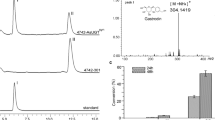Abstract
Flavonoid glycosides are known for their medicinal properties and potential use as natural sweeteners. In this study, Saccharomyces cerevisiae expressing a flavonoid glucosyltransferase from Dianthus caryophyllus was used as a whole-cell biocatalyst. The yeast system’s performance was characterized using the flavanone naringenin as a model substrate for the production of naringenin glycosides. It was found that final naringenin glycoside yields increased in a dose-dependent manner with increasing initial naringenin substrate concentrations. However, naringenin concentrations >0.5 mM did not give further enhancements in glycoside yield. In addition, a method for controlling overall selectivity was discovered where the glucose content in the culture medium could be altered to control the selectivity, making either naringenin-7-O-glucoside (N7O) or naringenin-4′-O-glucoside (N4O) the major products. The highest yields achieved were 87 mg/L of N7O and 82 mg/L of N4O using 40MSGI and 2xMSGI media, respectively. The effects of two intermediates involved in UDP-glucose biosynthesis, uridine 5′-monophosphate (UMP) and orotic acid, on glycoside yields were also determined. Addition of UMP to the culture medium significantly decreased glycoside yield. In contrast, addition of orotic acid to the culture medium significantly enhanced the glycoside yield and shifted the selectivity toward N7O. The highest naringenin glycoside yield achieved using 10 mM orotic acid in the 40MSGI media was 155 mg/L, a 71% conversion of substrate to product.






Similar content being viewed by others
References
Kren V, Martinkova L (2001) Glycosides in medicine: the role of glycosidic residue in biological activity. Curr Med Chem 8:1303–1328
Lim EK, Ashford DA, Hou B, Jackson RG, Bowles DJ (2004) Arabidopsis glycosyltransferases as biocatalysts in fermentation for regioselective synthesis of diverse quercetin glucosides. Biotechnol Bioeng 87:623–631
Kim J, Kim B, Park Y et al (2006) Characterization of flavonoid 7-O-glucosyltransferase from Arabidopsis thaliana. Biosci Biotechnol Biochem 70:1471–1477
Kim JH, Shin KH, Ko JH, Ahn JH (2006) Glucosylation of flavonols by Escherichia coli expressing glucosyltransferase from rice (Oryza sativa). J Biosci Bioeng 102:135–137
Lim EK, Ashford DA, Bowles DJ (2006) The synthesis of small-molecule rhamnosides through the rational design of a whole-cell biocatalysis system. Chembiochem 7:1181–1185
Willits MG, Giovanni M, Prata RTN et al (2004) Bio-fermentation of modified flavonoids: an example of in vivo diversification of secondary metabolites. Phytochemistry 65:31–41
Werner SR, Morgan JA (2009) Expression of a Dianthus flavonoid glucosyltransferase in Saccharomyces cerevisiae for whole-cell biocatalysis. J Biotechnol 142:233–241
Han X, Ren D, Fan P, Shen T, Lou H (2008) Protective effects of naringenin-7-O-glucoside on doxorubicin-induced apoptosis in H9C2 cells. Eur J Pharmacol 581:47–53
Horowitz RM, Gentili B (1963) Dihydrochalcone derivatives and their use as sweetening agents. US Pat. 3,087,821
Westall EB, Messing AW (1977) Salts of dihydrochalcone derivatives and their use as sweeteners. US Pat. 3,984,394
Jiang HX, Morgan JA (2004) Optimization of an in vivo plant P450 monooxygenase system in Saccharomyces cerevisiae. Biotechnol Bioeng 85:130–137
Mumberg D, Muller R, Funk M (1995) Yeast vector for the controlled expression of heterologous proteins in different genetic backgrounds. Gene 156:119–122
Gietz RD, Woods RA (2002) Transformation of yeast by lithium acetate/single-stranded carrier DNA/polyethylene glycol method. In: Guthrie C, Fink G (eds) Methods in enzymology, vol 350. Academic Press, San Diego, pp 87–96
Ni Y, Chen RR (2004) Accelerating whole-cell biocatalysis by reducing outer membrane permeability barrier. Biotechnol Bioeng 87:804–811
Koizumi S, Endo T, Tabata K, Ozaki A (1998) Large-scale production of UDP-galactose and globotriose by coupling metabolically engineered bacteria. Nat Biotechnol 16:847–850
Leonard E, Yan Y, Fowler ZL et al (2008) Strain improvement of recombinant Escherichia coli for efficient production of plant flavonoids. Mol Pharm 5:257–265
Hernandez LF, Espinosa JC, Fernandez-Gonzalez M, Briones A (2003) beta-Glucosidase activity in a Saccharomyces cerevisiae wine strain. Int J Food Microbiol 80:171–176
McMahon H, Zoecklein BW, Fugelsang K, Jasinski Y (1999) Quantification of glycosidase activities in selected yeasts and lactic acid bacteria. J Ind Microbiol Biotechnol 23:198–203
Acknowledgments
This work and SRW were supported by the School of Chemical Engineering, Purdue University and partially supported by NSF.
Author information
Authors and Affiliations
Corresponding author
Rights and permissions
About this article
Cite this article
Werner, S.R., Morgan, J.A. Controlling selectivity and enhancing yield of flavonoid glycosides in recombinant yeast. Bioprocess Biosyst Eng 33, 863–871 (2010). https://doi.org/10.1007/s00449-010-0409-7
Received:
Accepted:
Published:
Issue Date:
DOI: https://doi.org/10.1007/s00449-010-0409-7




